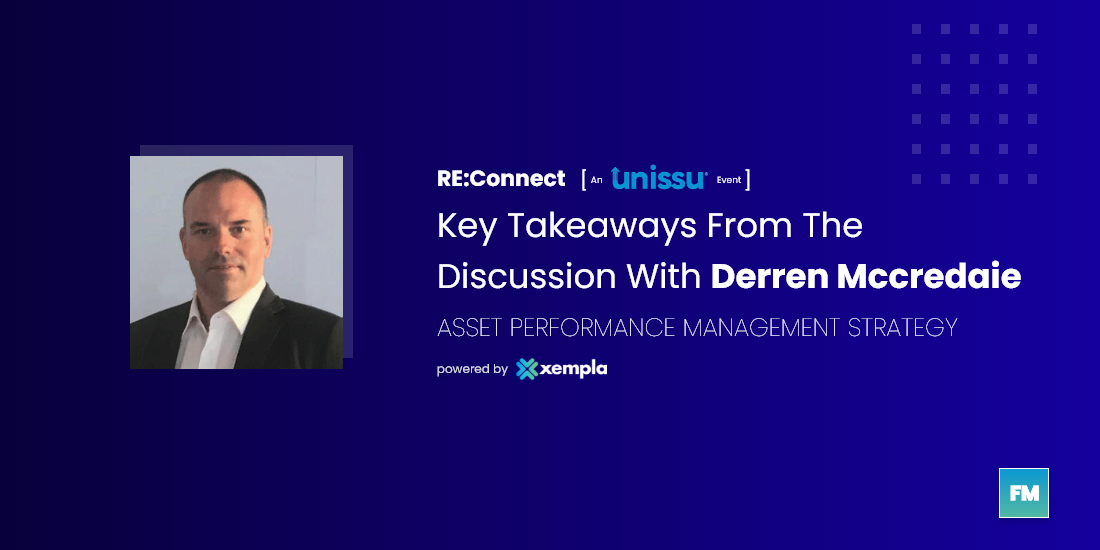Asset performance management (APM) is considered as the first dedicated step towards digital transformation. Getting it right is essential for the subsequent stages of the journey. While the concept has been around for some time, we must ask ourselves if we are truly implementing it effectively.
As technologies evolve and client expectations increase, we need to rethink our Asset performance management strategies in terms of both experience and operational cost. In this article, we explore the thoughts of Derren Mccredaie, head of estates at Sodexo healthcare, on the topic of APM and its importance.
Let’s look at the key takeaways from the session we had with him at RE.Connect event.
Experience and Data: Pushing Engineering Limits
Looking back on the previous year, Derren acknowledges that it was a year filled with uncertainties and unexpected conditions. He emphasizes that the challenges presented opportunities for his team to explore innovative approaches to engineering assets. They moved from assuming that assets would always perform according to their original design to finding ways to make assets do more than originally intended.
Derren’s team leveraged their wealth of operation and maintenance experience, combined with data analysis, to accomplish various tasks. According to Derren, understanding the capabilities and limitations of assets proved invaluable and should be considered as hidden data within the human brain.
Holistic Asset Performance Management
There are multiple definitions or ways to look at Asset performance management. Every stakeholder offers a unique perspective to look at APM. Derren believes there are three critical aspects of APM that should be included in applications: energy management, life cycle monitoring, and loss reduction.
Of course, energy management and life cycle monitoring is something that has to be there to identify and reduce the losses.
He added, it should be a combination of manual and technology/system interventions as there are some critical things for which you can not depend on systems. For instance, in healthcare they have specific areas where they do manual controlling and monitoring although they take the help of technologies.
The Path Forward: Are We There Yet?
The pandemic has made us realize the importance of reliability. Yet, when it comes to clubbing energy management, life cycle assessment with work order management systems in order to have a 360-degree view of the facility, how far are we from that actually being in the practice?
Derren think as an industry, we have a way to go there. And there are two reasons that hinder our progress: tech capabilities and a proven roadmap.
He said, “In general, I don’t think we have embraced the technology as disruptors or innovators would do. In my experience, we still rely on the manual process rather than going digital. In most cases, the service delivery model is inefficient that emphasizes manual work delivery.
It’s important to demonstrate the vales/use cases of APM and pursue those who are higher on the ladder.”
Start with small steps towards bigger accomplishments:
Derren suggested a gradual approach to digital transformation. It is important to start with pilot projects. It allows for smoother change management which comes in handy when you are on a journey to digital transformation as there will be many things you encounter which you haven’t seen before. So divide your progression into little steps to make your team or people on the shopfloor understand what they are doing and how digital will help them simplify their work. This will help in fostering greater acceptance and support.
Build it In house or partner as required:
Now once there is clarity on applications and tools that are going to be needed in the future. Facility management teams need to decide on how much of it they can build in-house.
To this dilemma Derren replied, “I don’t think most of the FM companies have an appetite to do that themselves, they depend on service providers through close alliances. Most of it depends on the type of FM contracts they have signed. If it’s just maintaining the existing tech stack then FM firms won’t need to introduce their own stack as a differentiator. Ideally for long-term contracts yes having a unique tech stack can be leveraged to win the client in the next bids.”
Well, that covers up when to approach a third-party technology provider for applications and when to leverage the in-house team’s capabilities to come up with innovative solutions.
We hope this session will give you clarity on holistic asset performance management, and help you start with it. Has your company found an asset performance management software yet?
In case you want to know more about the steps to start with your first trial project, this ebook will guide you through.
Planning to build on your existing stack or want to know more about where to start? Schedule a call with Umesh Bhutoria (Founder, CEO Xempla) to learn more about it

Leave a Reply